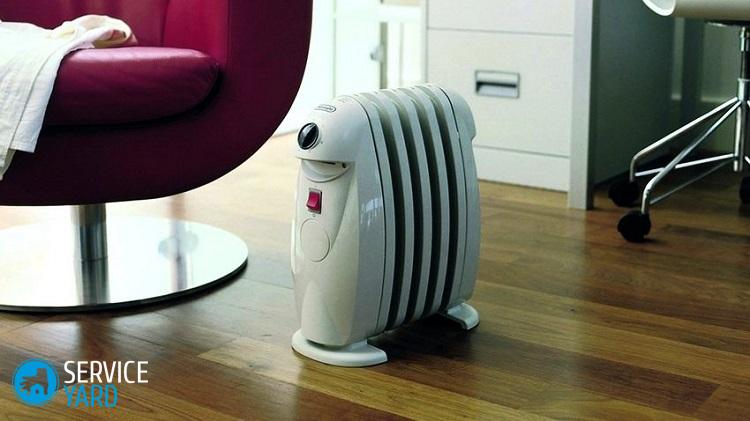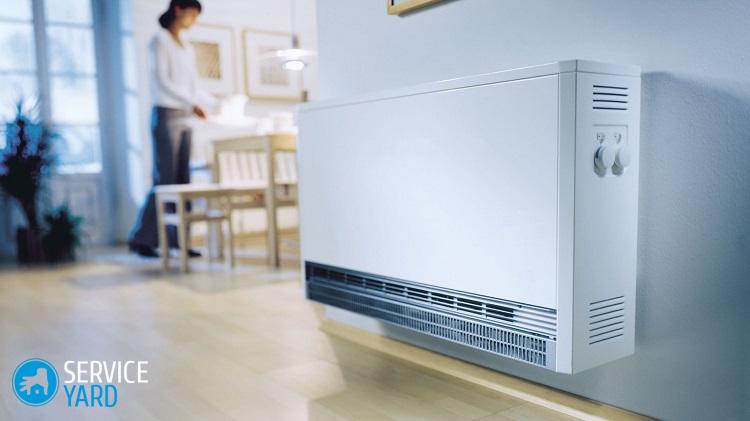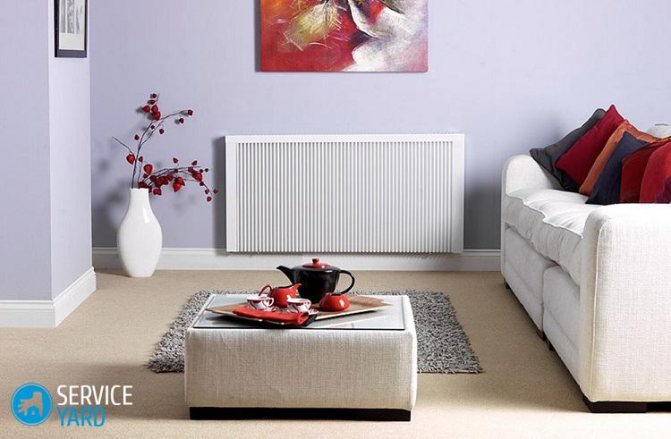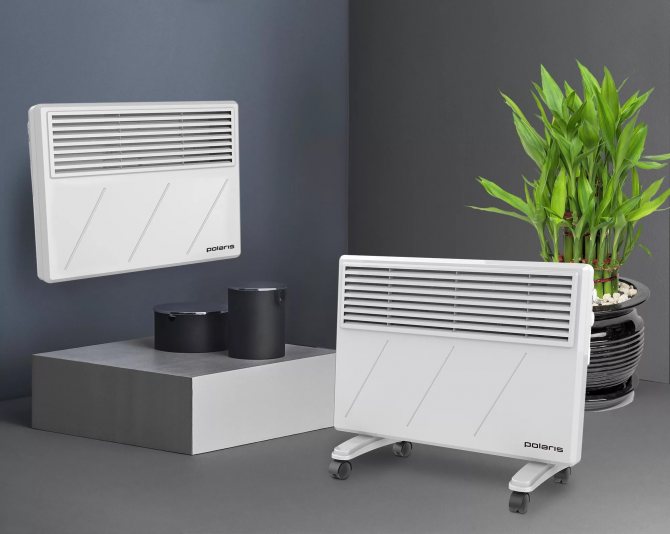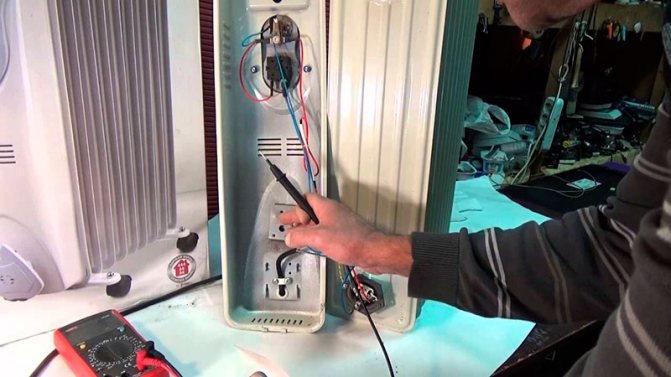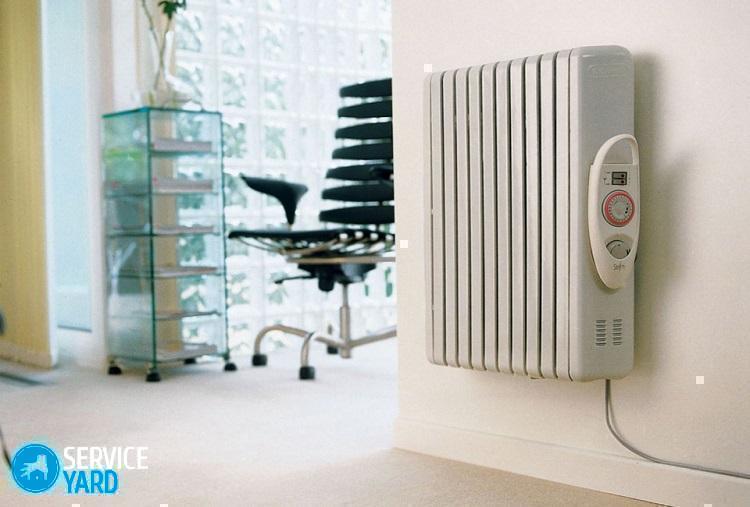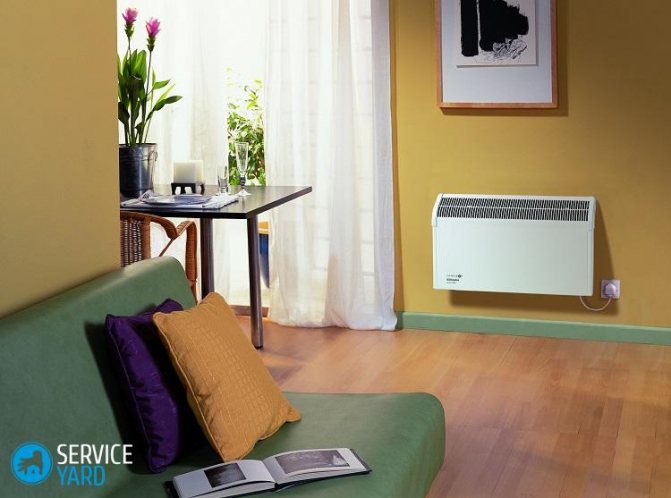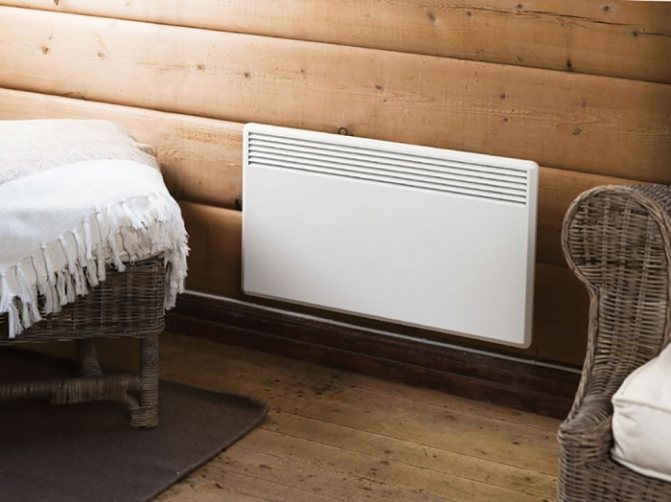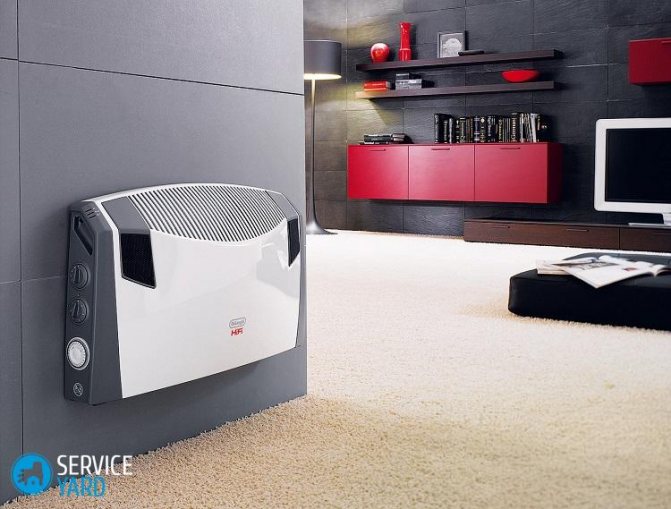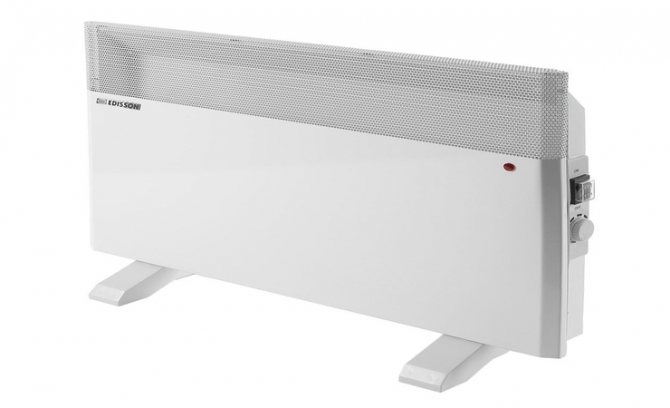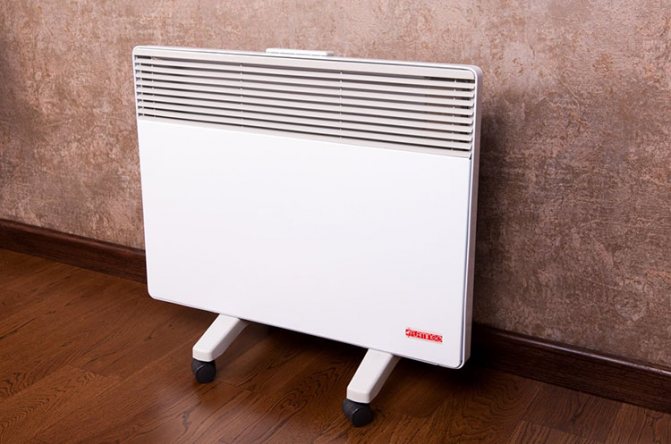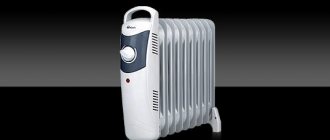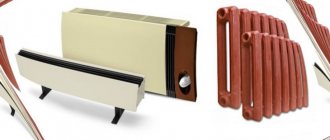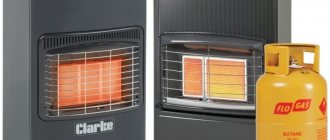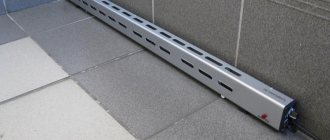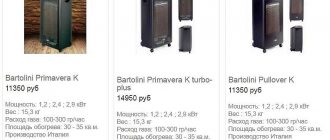When choosing a heating system for a house or apartment, it is important to evaluate several options, compare the costs of the device and further operation. If for different energy carriers this is determined by the ratio of tariffs for them, then for devices of the same type, their individual characteristics are taken into account.
For example, what is the best choice for a convector or an oil heater? Both devices operate from the mains, are similar in characteristics, even in stores they are put up for sale next to each other. How to choose the most suitable heater? Let's consider both devices in more detail and make a comparison.
The principle of operation and design of the convector
A convector is a heating device, the bulk of the heat from which is transferred to the room through convection (from 90%). This is a type of heat transfer in which flows of a gaseous medium are heated, passing through the device, and rise upward, transferring heat to the served room. The body of the electric convector does not heat up above 45 degrees.

Air flows from the convector.
The converter heater consists of several elements that allow you to organize the air flow and protect the device:
- housing with openings for air intake and supply;
- a heating element;
- devices for temperature regulation and protection of the device from overheating.
Converter heaters use electricity, gas or liquid from the heating system as a source of energy. Since the comparison is made with an electric oil heater, further we will consider the same type of convector.
The device and principle of operation of convector heaters
Convector heaters are not inferior to oil heaters in terms of design simplicity. It also has a heating element that raises the air temperature. The very name of the device comes from the principle of convection, when warm air rises up and cold air goes down. It is thanks to this air circulation that the room is heated.
To the question of how convectors differ from oil heaters, the answer is very simple - in the first type, the heating element directly heats the air, and not the body of the device. This offers a number of advantages, for example, the body of the device does not heat up that much. According to the type of energy consumed, electric, gas and water convectors are distinguished, each of which has its own characteristics, but structurally and in terms of power they do not differ too much from each other. The most common are electric convector heaters.
There are also infrared convectors that use infrared radiation to heat the air. As a rule, the efficiency of such models is low, therefore it is best to use combined convective-infrared heaters. They will be able to quickly and evenly heat the air even in a large room.
Convector heaters heat the room by circulating air
The design and features of the oil heater
When an oil heater is in operation, heat is supplied to the manned room both by convection and radiation. Radiation is a method of heat transfer in which a hot body emits infrared waves that heat nearby objects. Depending on the model, radiation accounts for up to 30% of the heat transfer balance of this heater. There are devices in which some of the convection heat transfer is increased. To do this, they use a protective casing in which holes are arranged to increase the flow of rising air.
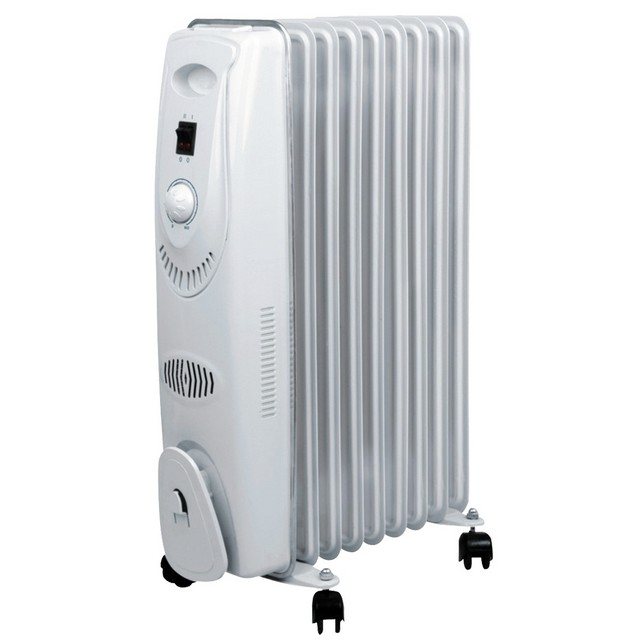

Oil heater.
The heating element in such a device does not interact directly with air. It is housed in a sealed housing filled with mineral oil. The high heat capacity of the oil makes it possible to make the device inert with its use: the heated liquid cools down for a long time, transferring heat to the environment at this time, even when it is already disconnected from the network. Structurally, the oil heater consists of a heating element, a body, protective and regulating automatics. Since heated oil is flammable, all instruments must be checked for the integrity of the case. Some models are equipped with a rollover protection sensor.
Prices of oil-fired electric heaters and convectors
The price category of a heating device depends on its power, manufacturer, availability of additional functions and other characteristics. The price of a low-power oil household electric heater will be about 2,500 rubles. The cost of more powerful models is in the range of 3-4 thousand rubles. The heating area and the number of sections affect the price of the device.
When choosing a convector, you must also pay attention to the power and manufacturer. Here the price can vary from 1,500 to 4,500 rubles. Infrared models are cheaper, you can buy such a heater for 1000 rubles or less.
If you want to buy a Delongy oil heater, then be prepared for serious expenses, since the products of a famous brand are more expensive. If you do not want to overpay for a trademark, then you can turn your attention to heating devices from less well-known companies.
How does a convector differ from an oil heater?
In order to answer the question of what is better to choose a convector or an oil heater for heating a room, it is necessary to determine the differences between devices and the difference in their operation. The main difference is the percentage of convection and radiation through which heat is transferred into the room. In the convector, the radiation is small, since it depends on the surface temperature.
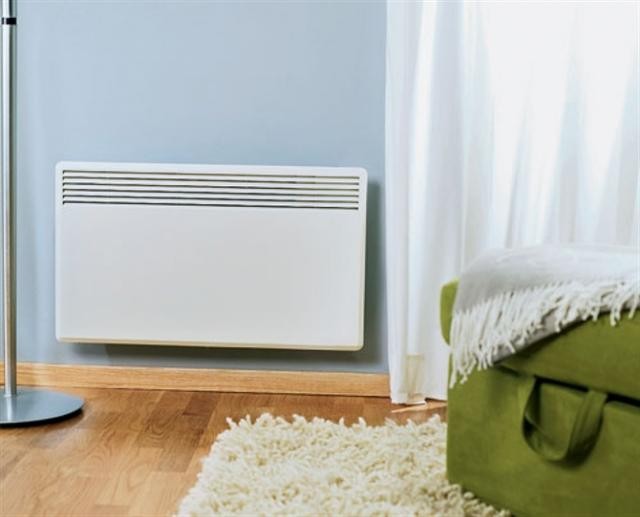

Convector on the wall.
The oil cooler heats up more and the radiation from it is greater. This is used for the possibility of local heating. A person near the oil cooler feels the heat emanating from it. There is much less such heat from the convector, most of it rises with convective air currents to the ceiling. All oil heaters are manufactured for floor standing installation. They are equipped with legs or wheels, which allows them to be quickly moved between rooms. Convectors are often hung on the wall, but there are also floor models. Installation under the window allows, due to the rising warm air, to reduce the leakage of cold air through the cracks and fogging during the cold season.


Oil heater in the casing.
DIY oil heater
If you want to save money, you can make an oil-type heating device yourself. To assemble an oil heater with your own hands, you only need a metal case. Heating element and oil. The answer to the question of which oil to use in oil heaters is purified and heat-resistant.
Diagram of the design of an oil-filled heater
This is necessary so that scale does not form on the walls of the heating element, and the oil itself does not boil at high temperatures. If you need to know more precisely which oil can be poured into oil heaters and which one cannot, then you should contact the professionals.
Useful advice! As a housing for a homemade heating device, you can use a conventional cast-iron battery. The material has good thermal conductivity, and inside such a case, you can easily install not only heating elements, but also a lot of other useful improvements.
The electrical circuit of an oil heater for self-assembly can be easily found on the Internet, and for greater efficiency, you need to choose the right heating element. It should be powerful enough, but without a magnesium anode, as it can quickly damage the heating element. Also, when assembling, it is necessary to understand the oil circulation pattern in the device.
To repair an oil heater with your own hands, you also need to understand the principle of operation of the device and the internal structure of the structure, as well as have special tools and skills, otherwise the repair may lead to more severe damage. If you are not confident in your abilities, then it is better to entrust this matter to experienced specialists.
Oil cooler wiring diagram
Which is more economical, a convector or an oil heater?
Which is better for saving, a convector or an oil heater? The efficiency of both devices is almost the same and approaches 100% (like other direct heating electric heaters). Almost all of the electrical energy consumed is converted into heat and remains in the room. But due to the difference in function, when the oil heater is operating, a little more energy is consumed to maintain the same temperature.
When the convector is switched on to maintain a certain temperature, it quickly reaches the required value and turns off. For example, it is required to ensure that the room is constantly 20 degrees. The switched on convector almost immediately goes into operation and starts warming up.
Having reached the set temperature, it turns off and cools down. The air is cooled and the thermostat is triggered, turning the device into operation again. The temperature difference when the device is turned on and off will whistle on the accuracy of the thermostat - more precisely electronic. During the operation of the oil cooler, a large inertness is observed. When you turn on and set the same temperature, heating starts with a significant delay. In some models, the exit to the specified mode occurs after 20 minutes. At this time, the oil warms up.
When the radiator has reached operating temperature, it transfers heat completely to the room. As in the convector, when it reaches 20 degrees (for example), the thermostat cuts off the power from the heating element. But the heater still remains hot and then transfers heat to the room. It cools down as slowly as heating. The room temperature becomes higher than the set one, heat loss through the enclosing structures increases. Due to this, energy consumption increases.


Convector on legs.
When, after a certain period of time, the room temperature drops to the thermostat setpoint, the power is turned on, but since the oil also heats up slowly, the room temperature does not rise or falls further during the warm-up period. The cycle is repeated - the radiator goes into operation.
The principle of operation, pros and cons of an oil heater
When choosing an oil heater for your home, you should understand how it works. Outwardly, it is a metal case, inside of which there is a container with mineral oil. After turning on the device, the heating element starts to work, which increases the temperature of the oil. The oil, in turn, heats up the metal case, and it gives off its heat to the environment. It takes quite a long amount of time, but the heat evenly spreads throughout the room.
Oil heater heats the room slowly but evenly
The intensity of air heating in such radiators, as a rule, is regulated, and the design is equipped with wheels for greater mobility. There are floor and wall oil heaters. It is advisable to buy the latter if there is a small child or pets in the house.This heater works for periods. When the room temperature rises to the desired level, the built-in sensor turns off the heating element. When the temperature drops, the opposite process takes place. Thus, the use of an electric oil heating radiator saves energy.
Of the advantages of an oil cooler, the following can be distinguished:
- High level of safety - all heating elements are hidden inside the case, so you can not be afraid of getting burned on the oil heater. In addition, most models are equipped with a special sensor that turns off the device in the event of a rollover.
- No noise during operation - you can safely install a household electric oil heater in your bedroom or office. Also, the device takes up little space, and it can be placed not only on the floor, but also on the wall.
- Long service life - the heating element of the oil cooler is reliable and durable, and the device itself can work for several days without interruption. Most modern models are equipped with built-in overheating protection.
- No unpleasant odor is emitted during operation. In addition, modern oil heaters (Delongy and other firms) do not dry out the air in the room, so you do not have to buy an air humidifier complete with the device.
- The price of the heater is quite low, so everyone can afford it.
Oil radiators have many advantages, such as quietness, economy and safety.
As with any household appliance, the oil heater has its drawbacks. Among them are:
- The air in the room takes a long time to warm up, especially when it comes to a large room. This problem can be corrected by buying an oil heater with a fan: the heated air will spread faster.
- The structure itself weighs a lot, so it is better if the device is equipped with wheels. It is worth hanging an oil heater on the wall only if there are reliable fasteners.
Useful advice! When choosing an oil heater, pay attention to the manufacturer. As a rule, brand awareness guarantees the high quality of the heating device.
What to choose an oil heater or convector
So which is better, an oil heater or a convector? If a device is chosen for the main heating system of a room, then it is more expedient to use convectors. They heat up rooms faster and allow more precise temperature control. When using electronic thermostats, the control accuracy reaches tenths of a degree. Although the energy consumption of these devices is approximately the same, the oil heater loses in energy efficiency to the convector. This is due to the inertness of the device, which does not allow maintaining the temperature with high accuracy. Temperature drops occur, which increase heat loss through the building envelope. Although, this difference is small.
When is it more convenient to use oil heaters? It is advisable to use them for reheating a room or part of it. Since most of the heat is transmitted by radiation, a person feels it near such a heater. Because of these properties, oil heaters are installed directly near places where people stay for a long time, even if there is another heating system in the building.
Which heater is better: oil or convector
In fact, it is impossible to answer this question unequivocally, because both types of devices are very good, just each is created to solve its own specific tasks.
So, oil heater, or a radiator is better suited to raise the temperature in a relatively small, enclosed space, such as a room. In fact, this is a container filled with mineral oil in contact with a hot heating element.As the oil heats up, it transfers its temperature to the outer shell of the heater, which in turn heats the air.
Such a device will heat the air in the room in about half an hour and will suit those users who use the services of the city power grid - only if the electricity in your city is cheap enough.
Otherwise, choosing an oil cooler is very simple: buy a device from trusted manufacturers and keep in mind: the more "ribs" it has, the larger the heat transfer area, on the one hand, and the lower the temperature on the case, on the other.
About convectors in detail
Convector operating principle completely different: cold air, passing through the heated spiral from the bottom up, heats up and, accordingly, heats the room.
It is very simple to determine what is in front of you - a radiator or a convector: at the top of the convector there is a kind of grill through which warm air escapes. It takes more than half an hour for such a heater to completely warm up the room, but due to its better energy efficiency, it is quite suitable for country houses, summer cottages and other places where electricity is expensive. Also, the convector will be very useful if you own a large city apartment, a house with panoramic windows or, for example, a winter garden.
In addition, since the convector does not need a large oil container, it takes up much less space, and, therefore, much more loved by designers, as it is embedded in any suitable niche.
